Promising Dietary Supplements with Potential Senotherapeutic Effects: Aqueous Extracts from Enzymatically Hydrolysed Hemp Seed Cake Flour and Hemp Seed Protein Concentrate
Abstract
1. Introduction
2. Materials and Methods
2.1. Reagents, Chemicals, and Materials
2.2. Description of Extract Preparation
2.3. RP-HPLC Analysis of Secondary Metabolite
2.4. Total Phenolic Content
2.5. Total Flavonoid Content
2.6. Total Protein Content
2.7. In Vitro Assays
2.7.1. Total Antioxidant Activity by Ferric Reducing Antioxidant Power Assay (FRAP)
2.7.2. Ability to Scavenge Free Radicals by 2,2-Diphenyl-1-picrylhydrazyl Scavenging Assay (DPPH Assay)
2.7.3. Ability to Reduce Lipid Peroxidation by Thiobarbituric Acid-Reactive Substance (TBARS) Analysis
2.7.4. Haemolysis Inhibition Assays
Isolation and Preparation of Blood Cells
Temperature-Induced Red Blood Cell Lysis Assay
2.7.5. In Vitro Protein Glycation
Preparation of Glycated Bovine Serum Albumin (BSA) Samples
Advanced Glycation End Products Formation
2.8. In Vivo Toxicity Assay
2.9. Statistical Analysis
3. Results and Discussion
3.1. Active Ingredient Content
3.2. In Vitro Antioxidant Activity of Extracts
3.3. In Vitro Anti-Inflammatory Activity of Extracts
3.4. Effect of the Extracts on Protein Glycation
3.5. Comparative Analysis of the Functionality of Extracts
3.6. Toxicity Assay in Zebrafish Larvae
4. Conclusions
Author Contributions
Funding
Institutional Review Board Statement
Informed Consent Statement
Data Availability Statement
Acknowledgments
Conflicts of Interest
Abbreviations
| HSCF_XL20 | Hemp seed cake flour after 20 min of hydrolysis with endo-1,4-β-xylanase |
| HSPC_XL20 | Hemp seed protein concentrate after 20 min of hydrolysis with endo-1,4-β-xylanase |
| HSCF_XL30 | Hemp seed cake flour after 30 min of hydrolysis with endo-1,4-β-xylanase |
| HSPC_XL30 | Hemp seed protein concentrate after 30 min of hydrolysis with endo-1,4-β-xylanase |
| HSCF_XL40 | Hemp seed cake flour after 40 min of hydrolysis with endo-1,4-β-xylanase |
| HSPC_XL40 | Hemp seed protein concentrate after 40 min of hydrolysis with endo-1,4-β-xylanase |
| HSCF_FP | Hemp seed cake flour hydrolysed by using Flavorpro® 795MDP |
| HSPC_FP | Hemp seed protein concentrate hydrolysed by using Flavorpro® 795MDP |
| HSCF_FP_DL | Hemp seed cake flour hydrolysed by using Flavorpro® 795MDP and Depol® 40L |
| HSPC_FP_DL | Hemp seed protein concentrate by using Flavorpro® 795MDP and Depol® 40L |
| HSCF | Untreated hemp seed cake flour |
| HSPC | Untreated hemp seed protein concentrate |
References
- Gollnhofer, J.F. Normalising alternative practices: The recovery, distribution and consumption of food waste. J. Mark. Manag. 2017, 33, 624–643. [Google Scholar] [CrossRef]
- Grizzetti, B.; Pretato, U.; Lassaletta, L.; Billen, G.; Garnier, J. The contribution of food waste to global and European nitrogen pollution. Environ. Sci. Policy 2013, 33, 186–195. [Google Scholar] [CrossRef]
- Torres-León, C.; Ramírez-Guzman, N.; Londoño-Hernandez, L.; Martinez-Medina, G.A.; Díaz-Herrera, R.; Navarro-Macias, V.; Aguilar, C.N. Food waste and byproducts: An opportunity to minimize malnutrition and hunger in developing countries. Front. Sustain. Food Syst. 2018, 2, 52. [Google Scholar] [CrossRef]
- Lin, Z.; Ooi, J.K.; Woon, K.S. An integrated life cycle multi-objective optimization model for health-environment-economic nexus in food waste management sector. Sci. Total Environ. 2022, 816, 151541. [Google Scholar] [CrossRef]
- Russo, E.B. History of Cannabis and Its Preparations in Saga, Science, and Sobriquet. Chem. Biodivers. 2007, 4, 1614–1648. [Google Scholar] [CrossRef] [PubMed]
- Farinon, B.; Molinari, R.; Costantini, L.; Merendino, N. The Seed of Industrial Hemp (Cannabis sativa L.): Nutritional Quality and Potential Functionality for Human Health and Nutrition. Nutrients 2020, 12, 1935. [Google Scholar] [CrossRef]
- Aloo, S.O.; Mwiti, G.; Ngugi, L.W.; Oh, D.-H. Uncovering the Secrets of Industrial Hemp in Food and Nutrition: The Trends, Challenges, and New-Age Perspectives. Crit. Rev. Food Sci. Nutr. 2022, 64, 5093–5112. [Google Scholar] [CrossRef]
- Rupasinghe, H.V.; Davis, A.; Kumar, S.K.; Murray, B.; Zheljazkov, V.D. Industrial hemp (Cannabis sativa subsp. sativa) as an emerging source for value-added functional food ingredients and nutraceuticals. Molecules 2020, 25, 4078. [Google Scholar]
- Hemp Seed Oil Market Analysis—Size, Trends & Forecast 2025 to 2035. Future Market Inside. 2025. Available online: https://www.futuremarketinsights.com/reports/hemp-seed-oil-market (accessed on 18 April 2025).
- Reguengo, L.M.; Salgaço, M.K.; Sivieri, K.; Júnior, M.R.M. Agro-industrial by-products: Valuable sources of bioactive compounds. Food Res. Int. 2022, 152, 110871. [Google Scholar] [CrossRef]
- Merlino, M.; Tripodi, G.; Cincotta, F.; Prestia, O.; Miller, A.; Gattuso, A.; Verzera, A.; Condurso, C. Technological, nutritional, and sensory characteristics of gnocchi enriched with hemp seed flour. Foods 2022, 11, 2783. [Google Scholar] [CrossRef]
- Hayflick, L. The limited in vitro lifetime of human diploid cell strains. Exp. Cell Res. 1965, 37, 614–636. [Google Scholar] [CrossRef] [PubMed]
- Hernandez-Segura, A.; Nehme, J.; Demaria, M. Hallmarks of cellular senescence. Trends Cell Biol. 2018, 28, 436–453. [Google Scholar] [CrossRef]
- Herranz, N.; Gil, J. Mechanisms and functions of cellular senescence. J. Clin. Investig. 2018, 128, 1238–1246. [Google Scholar] [CrossRef] [PubMed]
- Braumuller, H.; Wieder, T.; Brenner, E.; Assmann, S.; Hahn, M.; Alkhaled, M.; Schilbach, K.; Essmann, F.; Kneilling, M.; Griessinger, C.; et al. T-helper-1-cell cytokines drive cancer into senescence. Nature 2013, 494, 361–365. [Google Scholar] [CrossRef]
- Amor, C.; Feucht, J.; Leibold, J.; Ho, Y.J.; Zhu, C.; Alonso-Curbelo, D.; Mansilla-Soto, J.; Boyer, J.A.; Li, X.; Giavridis, T.; et al. Senolytic CAR T cells reverse senescence-associated pathologies. Nature 2020, 583, 127–132. [Google Scholar] [CrossRef]
- Chinta, S.J.; Woods, G.; Demaria, M.; Rane, A.; Zou, Y.; McQuade, A.; Rajagopalan, S.; Limbad, C.; Madden, D.T.; Campisi, J.; et al. Cellular senescence is induced by the environmental neurotoxin paraquat and contributes to neuropathology linked to parkinson’s disease. Cell Rep. 2018, 22, 930–940. [Google Scholar] [CrossRef] [PubMed]
- Zhang, P.; Kishimoto, Y.; Grammatikakis, I.; Gottimukkala, K.; Cutler, R.G.; Zhang, S.; Abdelmohsen, K.; Bohr, V.A.; Misra Sen, J.; Gorospe, M.; et al. Senolytic therapy alleviates Abeta-associated oligodendrocyte progenitor cell senescence and cognitive deficits in an Alzheimer’s disease model. Nat. Neurosci. 2019, 22, 719–728. [Google Scholar] [CrossRef]
- Aguayo-Mazzucato, C.; Andle, J.; Lee, T.B., Jr.; Midha, A.; Talemal, L.; Chipashvili, V.; Hollister-Lock, J.; van Deursen, J.; Weir, G.; Bonner-Weir, S. Acceleration of beta cell aging determines diabetes and senolysis improves disease outcomes. Cell Metab. 2019, 30, e124. [Google Scholar] [CrossRef]
- Franceschi, C.; Garagnani, P.; Parini, P.; Giuliani, C.; Santoro, A. Inflammaging: A new immune–metabolic viewpoint for age-related diseases. Nat. Rev. Endocrinol. 2018, 14, 576–590. [Google Scholar] [CrossRef]
- Borodkina, A.V.; Deryabin, P.I.; Giukova, A.A.; Nikolsky, N.N. “Social life” of senescent cells: What is SASP and why study it? Acta Naturae 2018, 10, 4–14. [Google Scholar] [CrossRef]
- Miller, S.J.; Darji, R.Y.; Walaieh, S.; Lewis, J.A.; Logan, R. Senolytic and senomorphic secondary metabolites as therapeutic agents in Drosophila melanogaster models of Parkinson’s disease. Front. Neurol. 2023, 14, 1271941. [Google Scholar] [CrossRef] [PubMed]
- Mavrogonatou, E.; Kletsas, D. Plant-Derived Senotherapeutics for the Prevention and Treatment of Intervertebral Disc Degeneration and Aging. Metabolites 2024, 14, 146. [Google Scholar] [CrossRef]
- Republic of Italy. DECRETO 4 Novembre 2019: Definizione di Livelli Massimi di Tetraidrocannabinolo (THC) Negli Alimenti (20A00016). Gazz. Uff. Della Repubb. Ital. 2019, 11, 3–6. Available online: https://www.gazzettaufficiale.it/eli/id/2020/01/15/20A00016/sg (accessed on 1 August 2022).
- Pavlovic, R.; Panseri, S.; Giupponi, L.; Leoni, V.; Citti, C.; Cattaneo, C.; Cavalletto, M.; Giorgi, A. Phytochemical and ecological analysis of two varieties of hemp (Cannabis sativa L.) grown in a mountain environment of Italian Alps. Front. Plant Sci. 2019, 10, 1265. [Google Scholar] [CrossRef]
- Disca, V.; Jaouhari, Y.; Carrà, F.; Martoccia, M.; Travaglia, F.; Locatelli, M.; Bordiga, M.; Arlorio, M. Effect of Carbohydrase Treatment on the Dietary Fibers and Bioactive Compounds of Cocoa Bean Shells (CBSs). Foods 2024, 13, 2545. [Google Scholar] [CrossRef]
- Takó, M.; Tunali, F.; Zambrano, C.; Kovács, T.; Varga, M.; Szekeres, A.; Papp, T.; Tugay, O.; Kerekes, E.B.; Krish, J.; et al. Phenolic Content, Antioxidant and Antimicrobial Properties of Hawthorn (Crataegus orientalis) Fruit Extracts Obtained via Carbohydrase-Assisted Extraction. Appl. Sci. 2024, 14, 9790. [Google Scholar] [CrossRef]
- Zhang, L.; You, Y.; Zhang, K.; Li, G.; Zhang, C. Improving solubility of rice protein powder by modifying its physicochemical properties by ultrasound-assisted protein-glutaminase. Food Chem. 2025, 464, 141627. [Google Scholar] [CrossRef]
- Garcia-Mora, P.; Frias, J.; Peñas, E.; Zieliński, H.; Giménez-Bastida, J.A.; Wiczkowski, W.; Zielinska, D.; Martinez-Villaluenga, C. Simultaneous release of peptides and phenolics with antioxidant, ACE-inhibitory and anti-inflammatory activities from pinto bean (Phaseolus vulgaris L. var. pinto) proteins by subtilisins. J. Funct. Foods 2015, 18, 319–332. [Google Scholar] [CrossRef]
- Kwiecień, I.; Smolin, J.; Beerhues, L.; Ekiert, H. The impact of media composition on production of flavonoids in agitated shoot cultures of the three Hypericum perforatum L. cultivars ‘Elixir,’ ‘Helos,’ and ‘Topas’. In Vitro Cell. Dev. Biol.-Plant 2018, 54, 332–340. [Google Scholar] [CrossRef]
- Patro, G.; Bhattamisra, S.K.; Mohanty, B.K.; Sahoo, H.B. In vitro and In vivo Antioxidant Evaluation and Estimation of Total Phenolic, Flavonoidal Content of Mimosa pudica L. Pharmacogn. Res. 2016, 8, 22–28. [Google Scholar] [CrossRef]
- Praparatana, R.; Maliyam, P.; Barrows, L.R.; Puttarak, P. Flavonoids and Phenols, the Potential Anti-Diabetic Compounds from Bauhinia strychnifolia Craib. Stem. Molecules 2022, 27, 2393. [Google Scholar] [CrossRef] [PubMed]
- Lowry, O.H.; Rosebrough, N.J.; Farr, A.L.; Randal, R.I. Protein measurement with the Folin phenol reagent. J. Biol. Chem. 1951, 193, 265–275. [Google Scholar] [CrossRef] [PubMed]
- Yoshino, M.; Murakami, K. Interaction of iron with polyphenolic compounds: Application to antioxidant characterization. Anal. Biochem. 1998, 257, 40–44. [Google Scholar] [CrossRef]
- Kotańska, M.; Kubacka, M.; Bednarski, M.; Nicosia, N.; Szafarz, M.; Jawień, W.; Müller, C.E.; Kieć-Kononowicz, K. The GPR18 agonist PSB-KD-107 exerts endothelium-dependent vasorelaxant effects. Pharmaceuticals 2021, 14, 799. [Google Scholar] [CrossRef]
- Sharma, O.P.; Bhat, T.K. DPPH antioxidant assay revisited. Food Chem. 2009, 113, 1202–1205. [Google Scholar] [CrossRef]
- Buege, J.A.; Aust, S.D. Microsomal lipid peroxidation. Methods Enzymol. 1978, 52, 302–310. [Google Scholar] [PubMed]
- Parvin, M.S.; Das, N.; Jahan, N.; Akhter, M.A.; Nahar, L.; Islam, M.E. Evaluation of in vitro anti-inflammatory and antibacterial potential of Crescentia cujete leaves and stem bark. BMC Res. Notes 2015, 8, 412. [Google Scholar] [CrossRef]
- Kotańska, M.; Wojtaszek, K.; Kubacka, M.; Bednarski, M.; Nicosia, N.; Wojnicki, M. The Influence of Caramel Carbon Quantum Dots and Caramel on Platelet Aggregation, Protein Glycation and Lipid Peroxidation. Antioxidants 2023, 13, 13. [Google Scholar] [CrossRef]
- Anwar, S.; Almatroudi, A.; Allemailem, K.S.; Jacob Joseph, R.; Khan, A.A.; Rahmani, A.H. Protective Effects of Ginger Extract against Glycation and Oxidative Stress-Induced Health Complications: An In Vitro Study. Processes 2020, 8, 468. [Google Scholar] [CrossRef]
- Nicosia, N.; Kwiecień, I.; Bednarski, M.; Głuch-Lutwin, M.; Mordyl, B.; Mika, K.; Hambaryan, R.; Miller, A.; Alesci, A.; Lauriano, E.R.; et al. Anti-diabetes and neuroprotection potential and primary safety studies of Isatis tinctoria L. hydroalcoholic leaf extract. Fitoterapia 2024, 177, 106138. [Google Scholar] [CrossRef]
- Siddhu, N.S.S.; Guru, A.; Kumar, R.C.S.; Almutairi, B.O.; Almutairi, M.H.; Juliet, A.; Vijayakumar, T.M.; Arockiaraj, J. Pro-inflammatory cytokine molecules from Boswellia serrate suppresses lipopolysaccharides induced inflammation demonstrated in an in-vivo zebrafish larval model. Mol. Biol. Rep. 2022, 49, 7425–7435. [Google Scholar] [CrossRef] [PubMed]
- Apostol, L.; Popa, M.; Mustatea, G. Cannabis sativa L partially skimmed flour as source of bio-compounds in the bakery industry. Rom. Biotechnol. Lett. 2015, 20, 10835–10844. [Google Scholar]
- Capcanari, T.; Covaliov, E.; Negoița, C.; Siminiuc, R.; Chirsanova, A.; Reșitca, V.; Țurcanu, D. Hemp Seed Cake Flour as a Source of Proteins, Minerals and Polyphenols and Its Impact on the Nutritional, Sensorial and Technological Quality of Bread. Foods 2023, 12, 4327. [Google Scholar] [CrossRef] [PubMed]
- Sciacca, F.; Virzì, N.; Pecchioni, N.; Melilli, M.G.; Buzzanca, C.; Bonacci, S.; Di Stefano, V. Functional End-Use of Hemp Seed Waste: Technological, Qualitative, Nutritional, and Sensorial Characterization of Fortified Bread. Sustainability 2023, 15, 12899. [Google Scholar] [CrossRef]
- Nakov, G.; Trajkovska, B.; Atanasova-Pancevska, N.; Daniloski, D.; Ivanova, N.; Lučan Čolić, M.; Jukić, M.; Lukinac, J. The Influence of the Addition of Hemp Press Cake Flour on the Properties of Bovine and Ovine Yoghurts. Foods 2023, 12, 958. [Google Scholar] [CrossRef]
- Tufarelli, V.; Losacco, C.; Tedone, L.; Passantino, L.; Tarricone, S.; Laudadio, V.; Colonna, M.A. Hemp seed (Cannabis sativa L.) cake as sustainable dietary additive in slow-growing broilers: Effects on performance, meat quality, oxidative stability and gut health. Vet. Q. 2023, 43, 1–12. [Google Scholar] [CrossRef]
- Grzesik, M.; Naparło, K.; Bartosz, G.; Sadowska-Bartosz, I. Antioxidant properties of catechins: Comparison with other antioxidants. Food Chem. 2018, 241, 480–492. [Google Scholar] [CrossRef]
- Siano, F.; Moccia, S.; Picariello, G.; Russo, G.L.; Sorrentino, G.; Di Stasio, M.; La Cara, F.; Volpe, M.G. Comparative Study of Chemical, Biochemical Characteristic and ATR-FTIR Analysis of Seeds, Oil and Flour of the Edible Fedora Cultivar Hemp (Cannabis sativa L.). Molecules 2019, 24, 83. [Google Scholar] [CrossRef]
- Absi, Y.; Revilla, I.; Vivar-Quintana, A.M. Commercial Hemp (Cannabis sativa Subsp. sativa) Proteins and Flours: Nutritional and Techno-Functional Properties. Appl. Sci. 2023, 13, 10130. [Google Scholar] [CrossRef]
- Pap, N.; Hamberg, L.; Pihlava, J.M.; Hellström, J.; Mattila, P.; Eurola, M.; Pihlanto, A. Impact of enzymatic hydrolysis on the nutrients, phytochemicals and sensory properties of oil hemp seed cake (Cannabis sativa L. FINOLA variety). Food Chem. 2020, 320, 126530. [Google Scholar] [CrossRef]
- Farinon, B.; Costantini, L.; Molinari, R.; Di Matteo, G.; Garzoli, S.; Ferri, S.; Ceccantoni, B.; Mannina, L.; Merendino, N. Effect of malting on nutritional and antioxidant properties of the seeds of two industrial hemp (Cannabis sativa L.) cultivars. Food Chem. 2022, 370, 131348. [Google Scholar] [CrossRef] [PubMed]
- Oseyko, M.; Sova, N.; Chornei, K. Substantiation of hemp seeds storage and processing technologies for functional, dietary and specialty products. Rev. Ukr. Food J. 2021, 10, 427–458. [Google Scholar] [CrossRef]
- Arango, S.; Kojić, J.; Perović, L.; Đermanović, B.; Stojanov, N.; Sikora, V.; Tomičić, Z.; Raffrenato, E.; Bailoni, L. Chemical Characterization of 29 Industrial Hempseed (Cannabis sativa L.) Varieties. Foods 2024, 13, 210. [Google Scholar] [CrossRef]
- Sharma, S.; Tamilselvan, T.; Shakeb, M.; Prabhasankar, P. Hydrothermal treatment of hemp seeds (Cannabis sativa L.): Impact on its dehulling yield, fatty acid profile and nutritional characteristics. J. Sci. Food Agric. 2023, 103, 2681–2689. [Google Scholar] [CrossRef] [PubMed]
- Aluko, R.E. Hemp seed (Cannabis sativa L.) proteins: Composition, structure, enzymatic modification, and functional or bioactive properties. In Sustainable Protein Sources; Academic Press: Cambridge, MA, USA, 2017; pp. 121–132. [Google Scholar]
- Teterycz, D.; Sobota, A.; Przygodzka, D.; Łysakowska, P. Hemp seed (Cannabis sativa L.) enriched pasta: Physicochemical properties and quality evaluation. PLoS ONE 2021, 16, e0248790. [Google Scholar] [CrossRef]
- Rodriguez-Martin, N.M.; Toscano, R.; Villanueva, A.; Pedroche, J.; Millan, F.; Montserrat-de la Paz, S.; Millan-Linares, M.C. Neuroprotective protein hydrolysates from hemp (Cannabis sativa L.) seeds. Food Funct. 2019, 10, 6732–6739. [Google Scholar] [CrossRef]
- Bernatoniene, J.; Kopustinskiene, D.M. The Role of Catechins in Cellular Responses to Oxidative Stress. Molecules 2018, 23, 965. [Google Scholar] [CrossRef]
- Emanuela Trovato, Katia Arena, Roberta La Tella, Francesca Rigano, Roberto Laganà Vinci, Paola Dugo, Luigi Mondello, Paolo Guarnaccia, Hemp seed-based food products as functional foods: A comprehensive characterization of secondary metabolites using liquid and gas chromatography methods. J. Food Compos. Anal. 2023, 117, 105151. [CrossRef]
- Izzo, L.; Castaldo, L.; Narváez, A.; Graziani, G.; Gaspari, A.; Rodríguez-Carrasco, Y.; Ritieni, A. Analysis of Phenolic Compounds in Commercial Cannabis sativa L. Inflorescences Using UHPLC-Q-Orbitrap HRMS. Molecules 2020, 25, 631. [Google Scholar] [CrossRef]
- Galanty, A.; Juncewicz, P.; Podolak, I.; Grabowska, K.; Słuzały, P.; Paśko, P. Comparative Analysis of Polyphenolic Profile and Chemopreventive Potential of Hemp Sprouts, Leaves, and Flowers of the Sofia Variety. Plants 2024, 13, 2023. [Google Scholar] [CrossRef]
- Frassinetti, S.; Moccia, E.; Caltavuturo, L.; Gabriele, M.; Longo, V.; Bellani, L.; Giorgi, G.; Giorgetti, L. Nutraceutical potential of hemp (Cannabis sativa L.) seeds and sprouts. Food Chem. 2018, 262, 56–66. [Google Scholar] [CrossRef] [PubMed]
- Rizzo, G.; Storz, M.A.; Calapai, G. The role of hemp (Cannabis sativa L.) as a functional food in vegetarian nutrition. Foods 2023, 12, 3505. [Google Scholar] [CrossRef] [PubMed]
- Imb, M.; Véghelyi, Z.; Maurer, M.; Kühnel, H. Exploring Senolytic and Senomorphic Properties of Medicinal Plants for Anti-Aging Therapies. Int. J. Mol. Sci. 2024, 25, 10419. [Google Scholar] [CrossRef]
- Banskota, A.H.; Tibbetts, S.M.; Jones, A.; Stefanova, R.; Behnke, J. Biochemical Characterization and In Vitro Digestibility of Protein Isolates from Hemp (Cannabis sativa L.) By-Products for Salmonid Feed Applications. Molecules 2022, 27, 4794. [Google Scholar] [CrossRef]
- Karabulut, G.; Feng, H.; Yemiş, O. Physicochemical and Antioxidant Properties of Industrial Hemp Seed Protein Isolate Treated by High-Intensity Ultrasound. Plant Foods Hum. Nutr. 2022, 77, 577–583. [Google Scholar] [CrossRef]
- Zago, E.; Nandasiri, R.; Thiyam-Holländer, U.; Michael Eskin, N.A. Influence of thermal treatments on the antioxidant activity of hemp cake polar extracts. J. Food Sci. Technol. 2022, 59, 3256–3265. [Google Scholar] [CrossRef]
- Phan, M.A.T.; Paterson, J.; Bucknall, M.; Arcot, J. Interactions between phytochemicals from fruits and vegetables: Effects on bioactivities and bioavailability. Crit. Rev. Food Sci. Nutr. 2017, 58, 1310–1329. [Google Scholar] [CrossRef]
- Isah, T. Stress and defense responses in plant secondary metabolites production. Biol. Res. 2019, 52, 39. [Google Scholar] [CrossRef] [PubMed]
- Xu, H.; Wang, Y.; Chen, Y.; Zhang, P.; Zhao, Y.; Huang, Y.; Wang, X.; Sheng, J. Subcellular Localization of Galloylated Catechins in Tea Plants [Camellia sinensis (L.) O. Kuntze] Assessed via Immunohistochemistry. Front. Plant Sci. 2016, 7, 728. [Google Scholar] [CrossRef]
- Kumar, S.; Pandey, A.K. Chemistry and biological activities of flavonoids: An overview. Sci. World J. 2013, 2013, 162750. [Google Scholar] [CrossRef] [PubMed] [PubMed Central]
- Munteanu, I.G.; Apetrei, C. Analytical Methods Used in Determining Antioxidant Activity: A Review. Int. J. Mol. Sci. 2021, 22, 3380. [Google Scholar] [CrossRef]
- Prior, R.L.; Wu, X.; Schaich, K. Standardized Methods for the Determination of Antioxidant Capacity and Phenolics in Foods and Dietary Supplements. J. Agric. Food Chem. 2005, 53, 4290–4302. [Google Scholar] [CrossRef] [PubMed]
- Chena, X.; Lianga, L.; Hanc, C. Borate suppresses the scavenging activity of gallic acid and plant polyphenol extracts on DPPH radical: A potential interference to DPPH assay. LWT Food Sci. Technol. 2020, 131, 3–16. [Google Scholar] [CrossRef]
- Vadivu, R.; Lakshmi, K.S. In vitro and in vivo anti-inflammatory activity of leaves of Symplocos cochinchinensis (Lour) Moore ssp. laurina. Bangladesh J. Pharmacol. 2008, 3, 121–124. [Google Scholar]
- Qamar, M.; Akhtar, S.; Ismail, T.; Yuan, Y.; Ahmad, N.; Tawab, A.; Ismail, A.; Barnard, R.T.; Cooper, M.A.; Blaskovich, M.A.T.; et al. Syzygium cumini (L.), Skeels fruit extracts: In vitro and in vivo anti-inflammatory properties. J. Ethnopharmacol. 2021, 271, 113805. [Google Scholar] [CrossRef]
- Kumari, L.; Abajy, M.Y.; Nayal, R. Invitro anti-inflammatory and anti-arthritic property of rhizopora mucronata leaves. Int. J. Pharm. Sci. Res. 2015, 6, 482–485. [Google Scholar]
- Boyina, R.; Kosanam, S.; Bhimana, S.; Gudimitla, R.B.; Duraiswamy, D. In-vitro and In Silico Assessment of Anti-inflammation Properties of Saponarin Extracted from Hordeum Vulgare. Anti-Inflamm. Anti-Allergy Agents Med. Chem. 2024, 23, 14–20. [Google Scholar] [CrossRef] [PubMed]
- Matacchione, G.; Borgonetti, V.; Ramini, D.; Silvestrini, A.; Ojetti, M.; Galeotti, N.; Olivieri, F. Zingiber officinale Roscoe Rhizome Extract Exerts Senomorphic and Anti-Inflammatory Activities on Human Endothelial Cells. Biology 2023, 12, 438. [Google Scholar] [CrossRef]
- Lee, P.Y.; Tsai, B.C.; Sitorus, M.A.; Lin, P.Y.; Lin, S.Z.; Shih, C.Y.; Lu, S.Y.; Lin, Y.M.; Ho, T.J.; Huang, C.Y. Ohwia caudata aqueous extract attenuates doxorubicin-induced mitochondrial dysfunction in Wharton’s jelly-derived mesenchymal stem cells. Environ. Toxicol. 2023, 38, 2450–2461. [Google Scholar] [CrossRef]
- Woo, J.; Shin, S.; Ji, H.; Ryu, D.; Cho, E.; Kim, Y.; Kim, J.; Park, D.; Jung, E. Isatis tinctoria L. Leaf Extract Inhibits Replicative Senescence in Dermal Fibroblasts by Regulating mTOR-NF-κB-SASP Signaling. Nutrients. 2022, 14, 1979. [Google Scholar] [CrossRef]
- Woo, J.; Shin, S.; Cho, E.; Ryu, D.; Garandeau, D.; Chajra, H.; Fréchet, M.; Park, D.; Jung, E. Senotherapeutic-like effect of Silybum marianum flower extract revealed on human skin cells. PLoS ONE 2021, 16, e0260545. [Google Scholar] [CrossRef] [PubMed]
- Zumerle, S.; Sarill, M.; Saponaro, M.; Colucci, M.; Contu, L.; Lazzarini, E.; Sartori, R.; Pezzini, C.; Rinaldi, A.; Scanu, A.; et al. Targeting senescence induced by age or chemotherapy with a polyphenol-rich natural extract improves longevity and healthspan in mice. Nat. Aging 2024, 4, 1231–1248. [Google Scholar] [CrossRef]
- Kim, C.S.; Park, S.; Kim, J. The role of glycation in the pathogenesis of aging and its prevention through herbal products and physical exercise. J. Exerc. Nutr. Biochem. 2017, 21, 55–61. [Google Scholar] [CrossRef] [PubMed]
- Vlassara, H.; Striker, G.E. Advanced glycation endproducts in diabetes and diabetic complications. Endocrinol. Metab. Clin. N. Am. 2013, 42, 697–719. [Google Scholar] [CrossRef]
- Knani, I.; Bouzidi, H.; Zrour, S.; Bergaoui, N.; Hammami, M.; Kerkeni, M. Increased serum concentrations of N-epsilon-carboxymethyllysine are related to the presence and the severity of rheumatoid arthritis. Ann. Clin. Biochem. 2018, 55, 430–436. [Google Scholar] [CrossRef]
- Papagrigoraki, A.; Del Giglio, M.; Cosma, C.; Maurelli, M.; Girolomoni, G.; Lapolla, A. Advanced glycation end products are increased in the skin and blood of patients with severe psoriasis. Acta Dermatol. Venereol. 2017, 97, 782–787. [Google Scholar] [CrossRef] [PubMed]
- Salahuddin, P.; Rabbani, G.; Khan, R.H. The role of advanced glycation end products in various types of neurodegenerative disease, a therapeutic approach. Cell. Mol. Biol. Lett. 2014, 19, 407–437. [Google Scholar] [CrossRef]
- Uribarri, J.; Cai, W.; Peppa, M.; Goodman, S.; Ferrucci, L.; Striker, G.; Vlassara, H. Circulating glycotoxins and dietary advanced glycation endproducts: Two links to inflammatory response, oxidative stress, and aging. J. Gerontol. A Biol. Sci. Med. Sci. 2007, 62, 427–433. [Google Scholar] [CrossRef]
- Thornalley, P.J. Use of aminoguanidine (Pimagedine) to prevent the formation of advanced glycation endproducts. Arch. Biochem. Biophys. 2003, 419, 31–40. [Google Scholar] [CrossRef]
- Ramkissoon, J.S.; Mahomoodally, M.F.; Ahmed, N.; Subratty, A.H. Antioxidant and anti-glycation activities correlates with phenolic composition of tropical medicinal herbs. Asian Pac. J. Trop. Med. 2013, 6, 561–569. [Google Scholar] [CrossRef]
- Mazzara, E.; Carletti, R.; Petrelli, R.; Mustafa, A.M.; Caprioli, G.; Fiorini, D.; Scortichini, S.; Dall’Acqua, S.; Sut, S.; Nuñez, S.; et al. Green extraction of hemp (Cannabis sativa L.) using microwave method for recovery of three valuable fractions (essential oil, phenolic compounds and cannabinoids): A central composite design optimization study. J. Sci. Food Agric. 2022, 102, 6220–6235. [Google Scholar] [CrossRef] [PubMed]
- Halkoum, R.; Salnot, V.; Capallere, C.; Plaza, C.; L’honoré, A.; Pays, K.; Friguet, B.; Nizard, C.; Petropoulos, I. Glyoxal Induces Senescence in Human Keratinocytes through Oxidative Stress and Activation of the Protein Kinase B/FOXO3a/p27KIP1 Pathway. J. Investig. Dermatol. 2022, 142, 2068–2078.e7. [Google Scholar] [CrossRef] [PubMed]
- Chahardehi, A.M.; Arsad, H.; Lim, V. Zebrafish as a Successful Animal Model for Screening Toxicity of Medicinal Plants. Plants 2020, 9, 1345. [Google Scholar] [CrossRef] [PubMed]
- More, S.M.; Layar, A.; Darade, S.; Shahu, A.; Kushwaha, N.; Kharwade, R.S.; Mahajan, U.N. Zebrafish: A New Emerging Model of Experimental Pharmacology. Int. J. Curr. Res. Rev. 2021, 13, 53–58. [Google Scholar] [CrossRef]
- Choi, T.Y.; Choi, T.I.; Lee, Y.R.; Choe, S.K.; Kim, C.H. Zebrafish as an animal model for biomedical research. Exp. Mol. Med. 2021, 53, 310–317. [Google Scholar] [CrossRef]
- Krug, R.G.; Clark, K.J. Elucidating cannabinoid biology in zebrafish (Danio rerio). Gene 2015, 570, 168–179. [Google Scholar] [CrossRef]

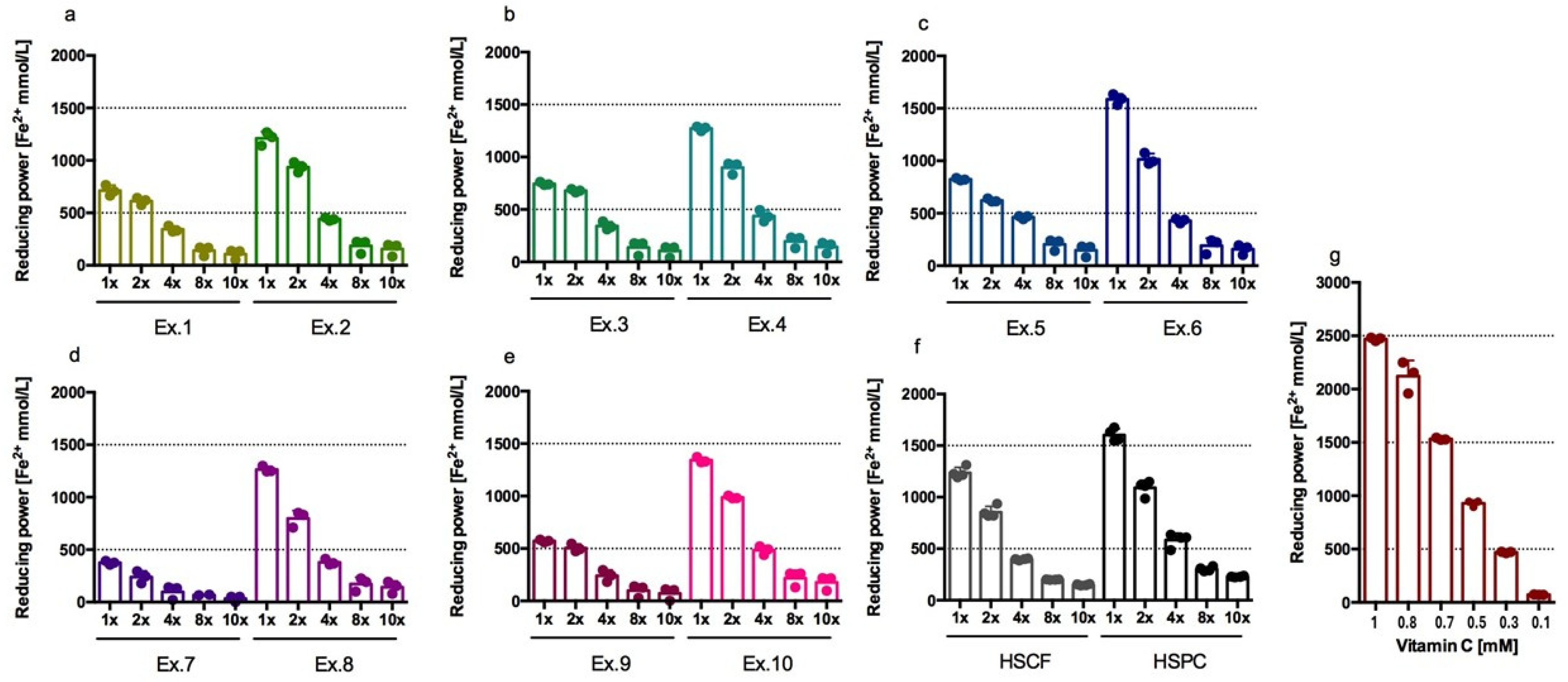
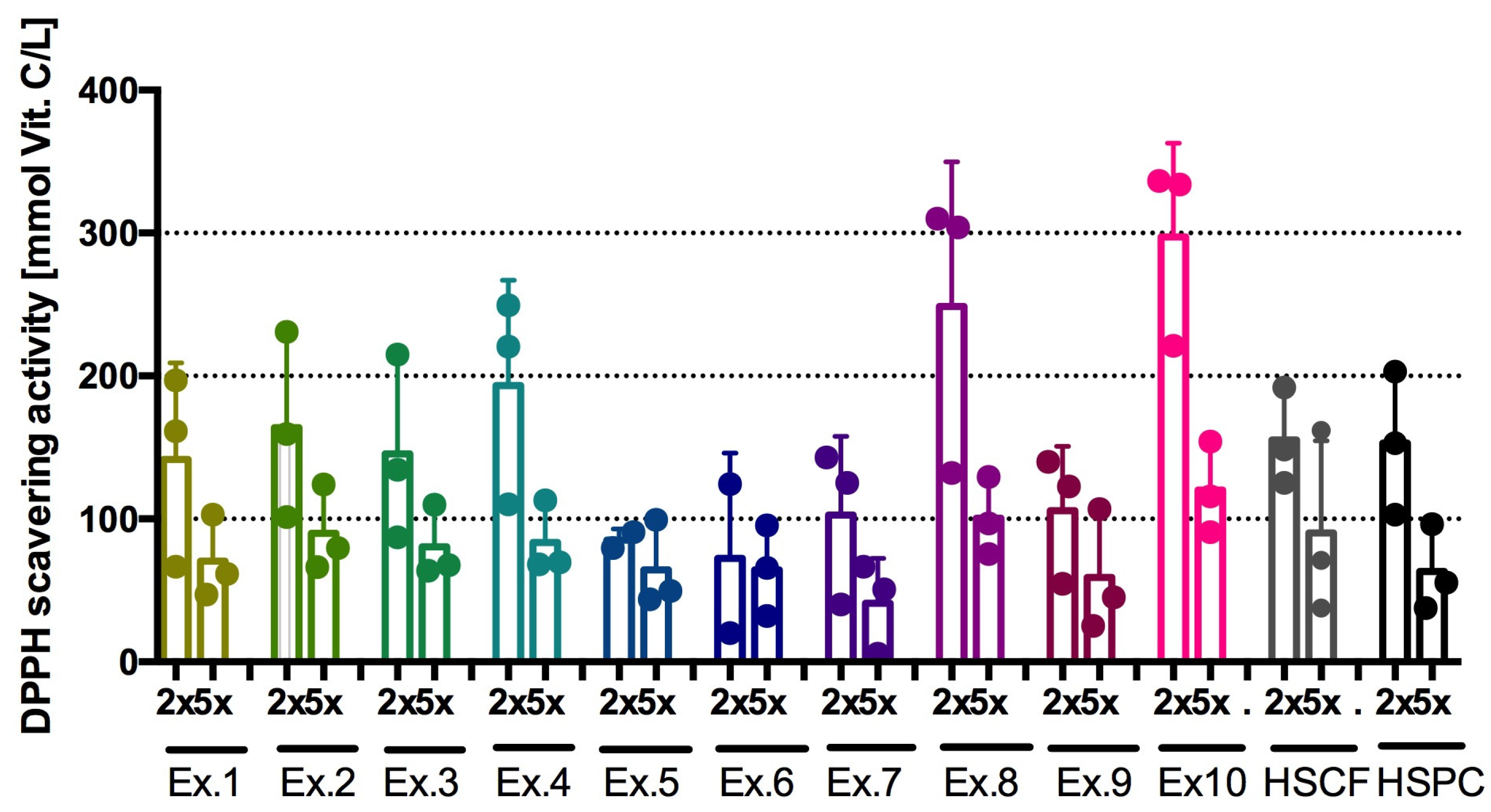
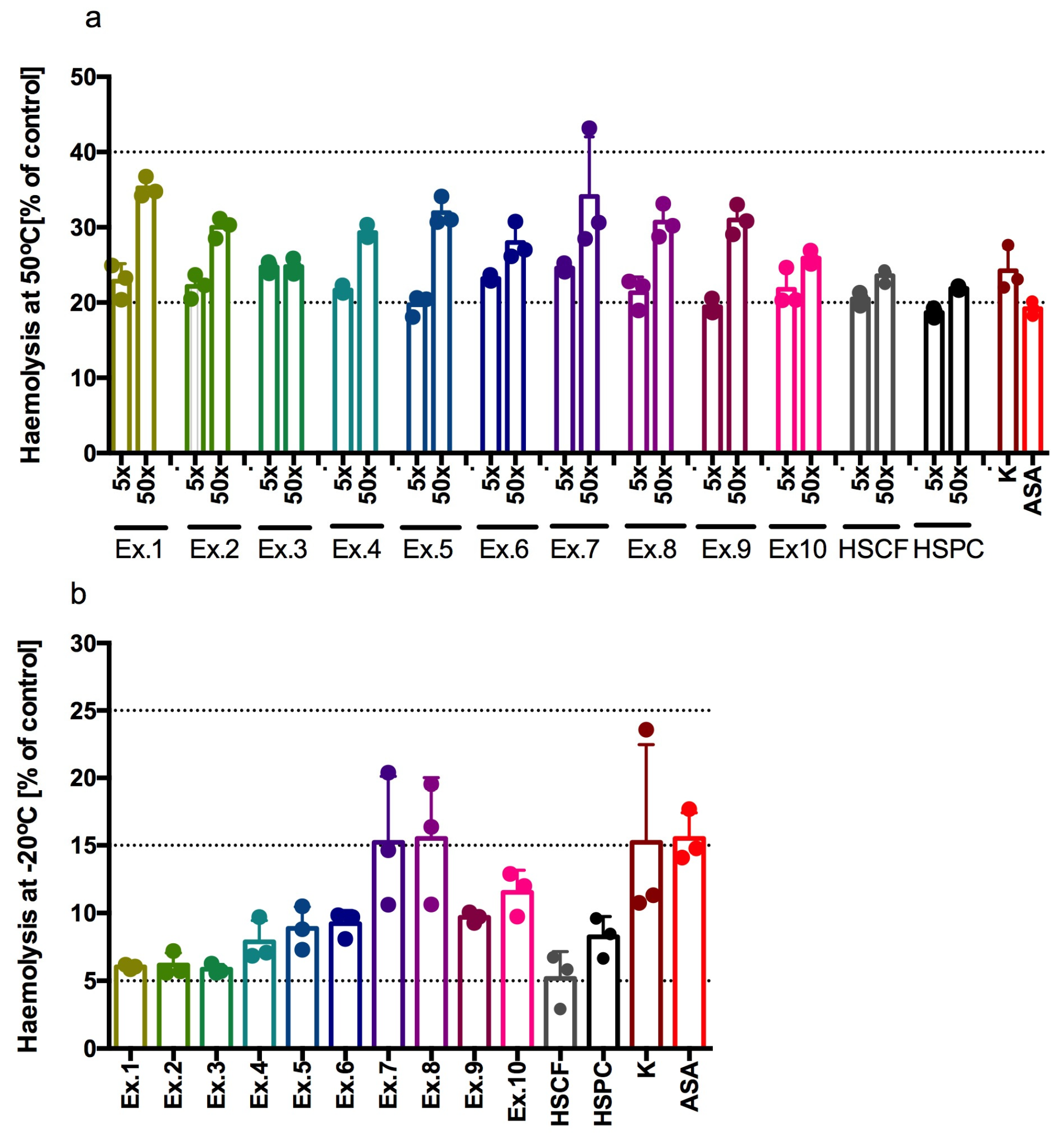

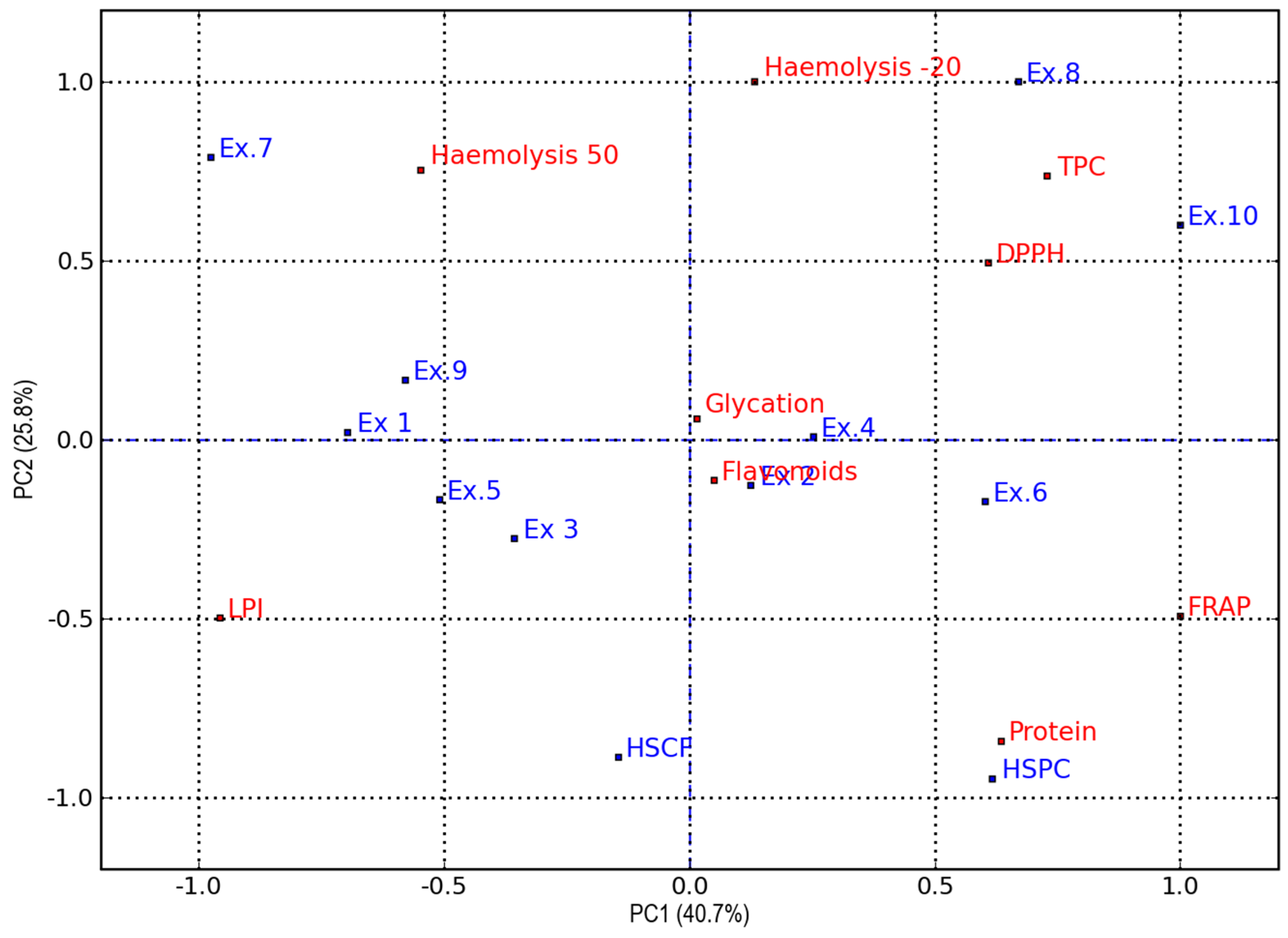
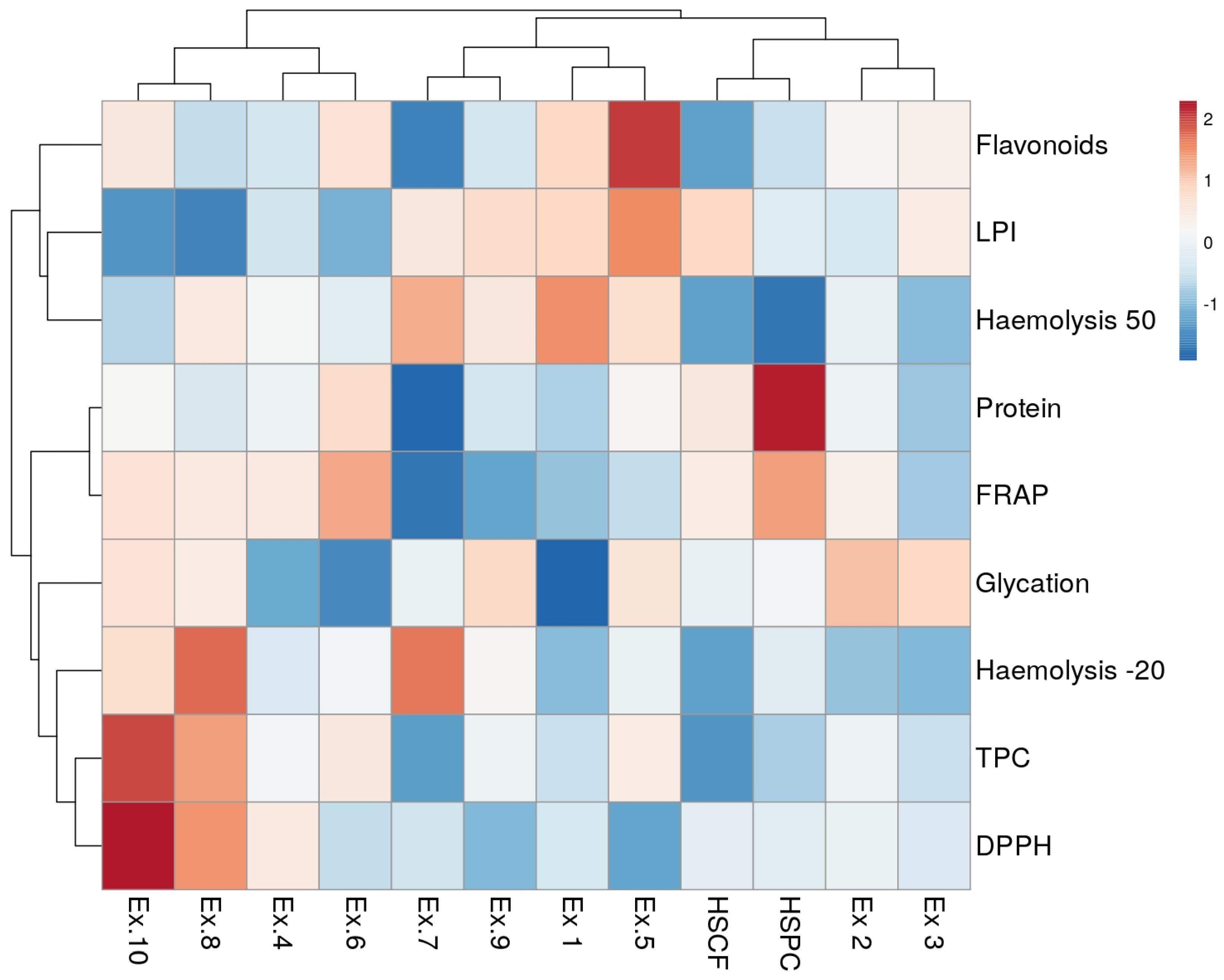
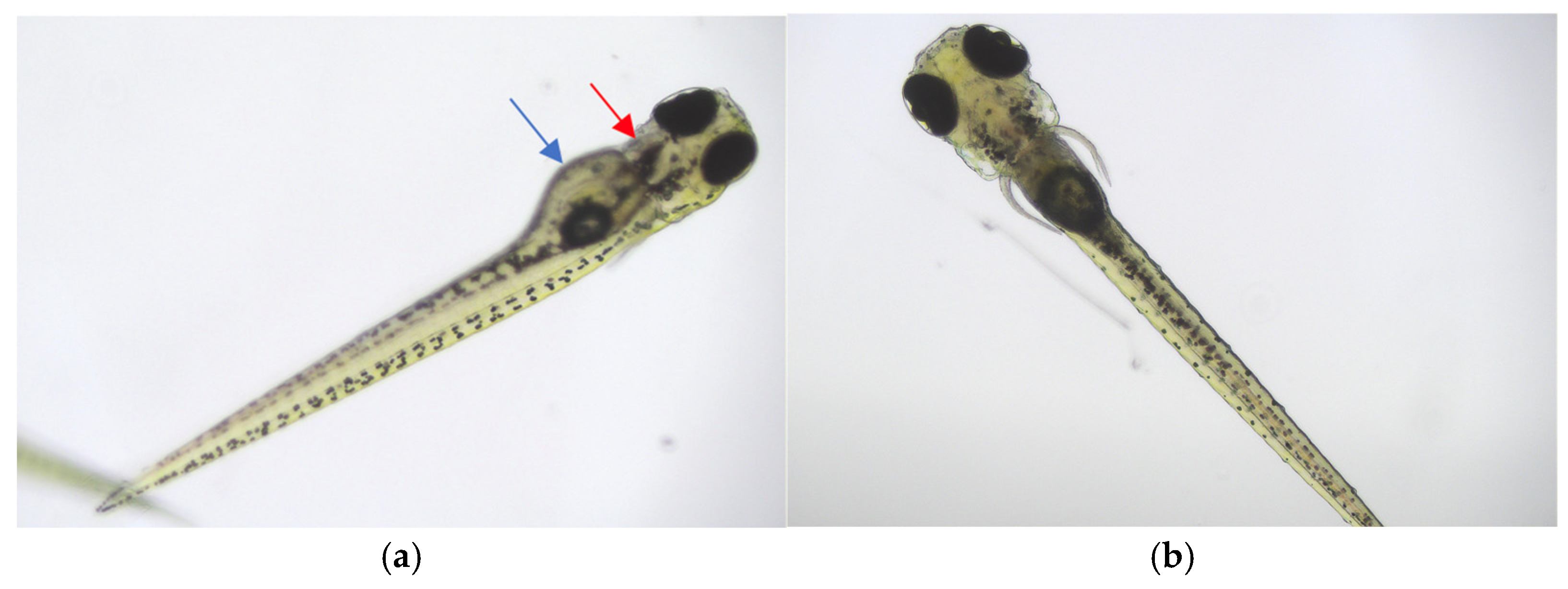
| Sample Identifier 1 | By-Product Powder | Powder/Water Ratio | Endo-1,4-β-Xylanase | Flavorpro® 795MDP | Depol® 40L | pH | T (°C) | Time (min) | Aqueous Extract pH 2 |
|---|---|---|---|---|---|---|---|---|---|
| HSCF_XL20 | HSCF | 01:10 | 1%w/w fibre | - | - | 6.00 | 50 | 20 | 5.67 ± 0.02 e |
| HSPC_XL20 | HSPC | 01:10 | 1%w/w fibre | - | - | 6.00 | 50 | 20 | 6.41 ± 0.05 a |
| HSCF_XL30 | HSCF | 01:10 | 1%w/w fibre | - | - | 6.00 | 50 | 30 | 5.60 ± 0.06 e |
| HSPC_XL30 | HSPC | 01:10 | 1%w/w fibre | - | - | 6.00 | 50 | 30 | 6.50 ± 0.03 a |
| HSCF_XL40 | HSCF | 01:10 | 1%w/w fibre | - | - | 6.00 | 50 | 40 | 6.05 ± 0.01 c |
| HSPC_XL40 | HSPC | 01:10 | 1%w/w fibre | - | - | 6.00 | 50 | 40 | 6.40 ± 0.02 a |
| HSCF_FP | HSCF | 01:10 | - | 1%w/w protein | - | 6.27 | 50 | 180 | 5.81 ± 0.08 d |
| HSPC_FP | HSPC | 01:10 | - | 1%w/w protein | - | 6.11 | 50 | 180 | 5.96 ± 0.13 cd |
| HSCF_FP_DL | HSCF | 01:10 | - | 1%w/w protein | 2%w/w fibre | 5.50 | 50 | 240 | 5.42 ± 0.15 e |
| HSPC_FP_DL | HSPC | 01:10 | - | 1%w/w protein | 2%w/w fibre | 5.50 | 50 | 240 | 5.53 ± 0.40 e |
| HSCF | HSCF | 01:10 | - | - | - | 6.27 | 50 | 180 | 6.27 ± 0.01 b |
| HSPC | HSPC | 01:10 | - | - | - | 6.11 | 50 | 180 | 6.11 ± 0.01 c |
| HE | NE | C | CG | BA | CA | E | CM | FA | RT | IQ | Q | L | K | A |
|---|---|---|---|---|---|---|---|---|---|---|---|---|---|---|
| HSCF_XL20 | 14.49 ±1.55 a,b,c | 203.23 ±16.73 c | 10.50 ±2.72 c,d,e | 0.10 ±0.03 a,b | 6.43 ±0.68 a,b,c | 73.17 ±6.74 a,b | 3.71 ±0.33 b | 1.57 ±0.06 a,b | 0.60 ±0.02 g | 0.33 ±0.01 g | 0.43 ±0.01 d | 0.35 ±0.02 d | 0.23 ±0.02 d | 2.37 ±0.34 a |
| HSPC_XL20 | 21.82 ±1.93 d | 260.27 ±18.33 a | 20.55 ±3.31 f | 0.14 ±0.01 b | 8.77 ±2.45 b,c | 86.93 ±6.21 b | 3.97 ±0.30 b,c | 2.14 ±0.13 b,c,d,g | 0.50 ±0.01 a | 0.18 ±0.02 a | 0.66 ±0.03 b | 0.11 ±0.01 a | 0.67 ±0.01 c | 7.32 ±0.37 c |
| HSCF_XL30 | 16.26 ±1.61 b,c,h | 248.63 ±10.20 a,c | 12.41 ±3.02 b,d,e | 0.11 ±0.01 a,b | 6.07 ±0.68 a,b,c,d | 53.30 ±4.93 d,e | 4.33 ±0.21 b,c | 1.89 ±0.26 a,b,c | 0.51 ±0.01 a | 0.24 ±0.01 b,c,d | 0.53 ±0.01 e | 0.28 ±0.02 c | 6.13 ±0.08 h | 2.29 ±0.05 a |
| HSPC_XL30 | 19.47 ±2.56 c,d,h | 270.50 ±18.60 a | 18.11 ±2.00 b,f | 0.11 ±0.02 a,b | 9.31 ±1.81 b,c | 81.61 ±3.24 b | 4.98 ±0.89 c | 2.44 ±0.30 c,d | 0.38 ±0.03 a | 0.21 ±0.02 b,c,d | 0.68 ±0.03 b | 0.11 ±0.02 a | 0.47 ±0.04 b | 7.19 ±0.15 c |
| HSCF_XL40 | 19.93 ±3.04 d,h | 294.00 ±24.16 a | 13.01 ±2.16 b,e | 0.09 ±0.02 a,b | 8.15 ±1.17 a,b,c | 60.01 ±3.72 a,d,e | 1.36 ±0.20 a | 0.56 ±0.03 e,f | 0.52 ±0.01 f | 0.44 ±0.01 e | 0.55 ±0.04 e | 0.21 ±0.02 b | 6.42 ±0.06 i | 2.50 ±0.14 a,b |
| HSPC_XL40 | 23.68 ±1.67 d | 246.63 ±18.91 a,c | 18.54 ±2.52 b,f | 0.08 ±0.01 a,b | 9.83 ±1.51 c | 72.99 ±7.24 a,b | 1.30 ±0.31 a | 1.09 ±0.16 f,g | 0.30 ±0.02 a | 0.17 ±0.01 a | 0.72 ±0.03 b | 0.42 ±0.03 e | 5.11 ±0.03 g | 2.33 ±0.07 a |
| HSCF_FP | 4.30 ±0.75 e | 115.88 ±9.98 b | 1.25 ±0.25 a | 0.19 ±0.01 b,c | 1.66 ±0.32 e | 15.85 ±3.84 c | 1.11 ±0.46 a | 2.59 ±0.33 d | 0.59 ±0.04 d,e | 0.18 ±0.02 a | 0.25 ±0.04 a | 0.11 ±0.01 a | 0.88 ±0.03 e | 5.21 ±0.09 d |
| HSPC_FP | 11.44 ±0.70 a,b,g | 261.51 ±18.38 a | 6.66 ±1.35 a,c,d | 0.31 ±0.04 c,d | 5.64 ±0.29 a,b,d | 45.89 ±2.94 d,f | 0.79 ±0.17 a | 2.06 ±0.21 a,b,c,d | 0.27 ±0.03 g | 0.12 ±0.01 f | 0.33 ±0.01 c | 0.08 ±0.01 a | 2.07 ±0.06 f | 2.98 ±0.13 b |
| HSCF_FP_DL | 10.21 ±1.35 a,f,g | 262.75 ±22.53 a | 2.93 ±1.00 a | 0.40 ±0.02 d | 4.31 ±0.14 a,d,e | 37.19 ±3.68 f | 0.65 ±0.01 a | 1.47 ±0.26 a,g | 0.35 ±0.02 c,d | 0.25 ±0.02 c,d | 0.19 ±0.02 a | 0.18 ±0.01 B90 | 0.37 ±0.01 b | 2.61 ±0.09 a,b |
| HSPC_FP_DL | 14.62 ±1.40 a,b,c | 426.15 ±25.64 d | 4.64 ±0.81 a,c | 0.58 ±0.11 e | 6.85 ±1.41 a,b,c | 62.45 ±5.55 a,e | 1.18 ±0.03 a | 1.89 ±0.13 a,b,c | 0.21 ±0.01 c | 0.20 ±0.01 a,b | 0.36 ±0.02 c,d | 0.10 ±0.01 a | 0.72 ±0.01 c | 2.68 ±0.03 a,b |
| HSCF | 5.82 ±0.30 e,f | 106.34 ±9.92 b | 2.12 ±0.77 a | 0.01 ±0.00 a | 2.22 ±0.28 d,e | 9.64 ±1.22 c | 0.63 ±0.05 a | 0.21 ±0.02 e | 0.08 ±0.01 b | 0.26 ±0.01 d | 0.18 ±0.02 a | 0.09 ±0.01 a | 0.06 ±0.01 a | 2.36 ±0.02 a |
| HSPC | 6.85 ±0.23 e,f,g | 124.92 ±8.50 b | 3.04 ±1.11 a | 0.01 ±0.00 a | 4.31 ±1.52 a,d,e | 12.84 ±2.04 c | 0.73 ±0.11 a | 0.58 ±0.01 e,f | 0.10 ±0.01 b | 0.43 ±0.02 e | 0.22 ±0.02 a | 0.07 ±0.01 a | 0.10 ±0.01 a | 2.24 ±0.07 a |
| HSCF Extracts | % Vitamin C Activity | HSPC Extracts | % Vitamin C Activity |
|---|---|---|---|
| HSCF_XL20 | 30.91 ± 2.24 | HSPC_XL20 | 52.56 ± 2.78 |
| HSCF_XL30 | 32.35 ± 0.67 | HSPC_XL30 | 55.22 ± 0.95 |
| HSCF_XL40 | 35.77 ± 0.50 | HSPC_XL40 | 68.85 ± 2.23 |
| HSCF_FP | 16.29 ± 0.76 | HSPC_FP | 54.90 ± 1.31 |
| HSCF_FP_DL | 25.41 ± 0.58 | HSPC_FP_DL | 58.26 ± 1.17 |
| HSCF | 52.20 ± 2.08 | HSPC | 66.61 ± 2.44 |
| HSCF Extracts | % Vitamin C Activity | HSPC Extracts | % Vitamin C Activity |
|---|---|---|---|
| HSCF_XL20 | 11.34 ± 4.78 | HSPC_XL20 | 13.33 ± 4.37 |
| HSCF_XL30 | 11.62 ± 4.21 | HSPC_XL30 | 16.13 ± 6.37 |
| HSCF_XL40 | 6.45 ± 1.87 | HSPC_XL40 | 7.77 ± 1.11 |
| HSCF_FP | 7.97 ± 6.04 | HSPC_FP | 21.20 ± 9.30 |
| HSCF_FP_DL | 8.31 ± 5.17 | HSPC_FP_DL | 25.93 ± 6.51 |
| HSCF | 19.73 ± 4.27 | HSPC | 18.96 ± 4.27 |
| Hemp Extracts Diluted 5 Times | % Carvedilol Activity |
|---|---|
| HSCF_XL20 | 26.03 ± 0.05 |
| HSPC_XL20 | 16.54 ± 0.06 |
| HSCF_XL30 | 22.52 ± 0.06 |
| HSPC_XL30 | 15.93 ± 0.03 |
| HSCF_XL40 | 31.89 ± 0.06 |
| HSPC_XL40 | 11.92 ± 0.04 |
| HSCF_FP | 23.41 ± 0.05 |
| HSPC_FP | 9.15 ± 0.02 |
| HSCF_FP_DL | 25.45 ± 0.03 |
| HSPC_FP_DL | 10.20 ± 0.03 |
| HSCF | 26.03 ± 0.01 |
| HSPC | 17.37 ± 0.03 |
| Carvedilol 1mM | 100 ± 0.01 |
| Ketoprofen 1 mM | 5.91 ± 0.06 |
| Ketoprofen 0.1 mM | 7.18 ± 0.06 |
| Indomethacin 1 mM | 30.90 ± 0.02 |
| Indomethacin 0.1 mM | 25.51 ± 0.02 |
| ASA 0.1mM | 64.76 ± 0.04 |
| Sample | Survivability (%) | Survivability (%) | Survivability (%) |
|---|---|---|---|
| Control | 90 ± 14.14 | ||
| Hemp Extracts | 10× Diluted | 50× Diluted | 100× Diluted |
| HSCF_XL20 | 100 ± 0.00 | 100 ± 0.00 | 100 ± 0.00 |
| HSPC_XL20 | 100 ± 0.00 | 100 ± 0.00 | 100 ± 0.00 |
| HSCF_XL30 | 85 ± 7.07 | 90 ± 0.00 | 90 ± 0.00 |
| HSPC_XL30 | 100 ± 0.00 | 100 ± 0.00 | 100 ± 0.00 |
| HSCF_XL40 | 100 ± 0.00 | 100 ± 0.00 | 100 ± 0.00 |
| HSPC_XL40 | 100 ± 0.00 | 100 ± 0.00 | 100 ± 0.00 |
| HSCF_FP | 100 ± 0.00 | 100 ± 0.00 | 100 ± 0.00 |
| HSPC_FP | 100 ± 0.00 | 100 ± 0.00 | 100 ± 0.00 |
| HSCF_FP_DL | 100 ± 0.00 | 95 ± 7.07 | 100 ± 0.00 |
| HSPC_FP_DL | 80 ± 14.14 | 95 ± 7.07 | 100 ± 0.00 |
| HSCF | 95 ± 7.07 | 100 ± 0.00 | 100 ± 0.00 |
| HSPC | 85 ± 7.07 | 100 ± 0.00 | 100 ± 0.00 |
Disclaimer/Publisher’s Note: The statements, opinions and data contained in all publications are solely those of the individual author(s) and contributor(s) and not of MDPI and/or the editor(s). MDPI and/or the editor(s) disclaim responsibility for any injury to people or property resulting from any ideas, methods, instructions or products referred to in the content. |
© 2025 by the authors. Licensee MDPI, Basel, Switzerland. This article is an open access article distributed under the terms and conditions of the Creative Commons Attribution (CC BY) license (https://creativecommons.org/licenses/by/4.0/).
Share and Cite
Miller, A.; Kwiecień, I.; Bednarski, M.; Zygmunt, M.; Sapa, J.; Sablik, M.; Lombardo, G.P.; Condurso, C.; Merlino, M.; Kotańska, M. Promising Dietary Supplements with Potential Senotherapeutic Effects: Aqueous Extracts from Enzymatically Hydrolysed Hemp Seed Cake Flour and Hemp Seed Protein Concentrate. Antioxidants 2025, 14, 734. https://doi.org/10.3390/antiox14060734
Miller A, Kwiecień I, Bednarski M, Zygmunt M, Sapa J, Sablik M, Lombardo GP, Condurso C, Merlino M, Kotańska M. Promising Dietary Supplements with Potential Senotherapeutic Effects: Aqueous Extracts from Enzymatically Hydrolysed Hemp Seed Cake Flour and Hemp Seed Protein Concentrate. Antioxidants. 2025; 14(6):734. https://doi.org/10.3390/antiox14060734
Chicago/Turabian StyleMiller, Anthea, Inga Kwiecień, Marek Bednarski, Małgorzata Zygmunt, Jacek Sapa, Mateusz Sablik, Giorgia Pia Lombardo, Concetta Condurso, Maria Merlino, and Magdalena Kotańska. 2025. "Promising Dietary Supplements with Potential Senotherapeutic Effects: Aqueous Extracts from Enzymatically Hydrolysed Hemp Seed Cake Flour and Hemp Seed Protein Concentrate" Antioxidants 14, no. 6: 734. https://doi.org/10.3390/antiox14060734
APA StyleMiller, A., Kwiecień, I., Bednarski, M., Zygmunt, M., Sapa, J., Sablik, M., Lombardo, G. P., Condurso, C., Merlino, M., & Kotańska, M. (2025). Promising Dietary Supplements with Potential Senotherapeutic Effects: Aqueous Extracts from Enzymatically Hydrolysed Hemp Seed Cake Flour and Hemp Seed Protein Concentrate. Antioxidants, 14(6), 734. https://doi.org/10.3390/antiox14060734








